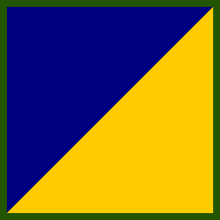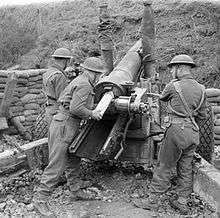Pembroke Yeomanry
| Pembroke Yeomanry | |
|---|---|
 | |
| Active | 1794 – present |
| Country |
|
| Branch |
Yeomanry (First World War) Royal Artillery (Second World War) Royal Logistic Corps (current) |
| Size | One Squadron |
| Battle honours |
Fishguard South Africa 1901 First World War Gaza Tell'Asus Jericho Egypt 1916–17 Jerusalam Palestine 1917–18 Somme 1918 Bapaume 1918 Epehy Hindenburg Line Pursuit to Mons France and Flanders 1918 Second World War No battle honours were awarded. It is tradition within artillery units that the Regiment's guns represent its colours and battle honours.[1] |
Now a squadron of the Royal Logistic Corps the Pembroke Yeomanry were originally formed in 1794, by Lord Milford[2] when King George III was on the throne, William Pitt the Younger was Prime Minister of Great Britain, and across the English Channel, Britain was faced by a French nation that had recently guillotined its King and which possessed a revolutionary army numbering half a million men. The Prime Minister proposed that the English Counties form a force of Volunteer Yeoman Cavalry that could be called on by the King to defend the country against invasion or by the Lord Lieutenant to subdue any civil disorder within the country.[3]
In 1797 the French Republican La Legion Noire landed off Carregwastad Point, in what would be the last invasion of Britain, only to surrender to a much smaller force including the Pembroke Yeomanry hastily assembled under Lord Cawdor.[2] Two of the French frigates involved were captured and one was re-commissioned in the Royal Navy as HMS Fisgard.[2] In 1853 Queen Victoria awarded the battle honour Fishguard upon the Regiment.[2] The unit became the first volunteer unit to receive a battle honour and remains the only unit still serving in the British Army to bear the name of an engagement on British soil.[2]
History
Boer War
During the Boer War the Yeomanry provided the 30th (Pembrokshire) Company of the 9th (Welsh) Battalion of Imperial Yeomanry, landing in South Africa in 1890 to fight as Mounted Infantry, and replacing them, a second 30th Company in 1901, both saw considerable action.[4]
Creation of The Territorial Force
The regiment was formed on the creation of the Territorial Force in April 1908 and placed under orders of the South Wales Mounted Brigade.[5]
First World War
| South Wales Mounted Brigade |
|---|
|
Organisation on 4 August 1914 |
|
Assigned units
|
|
In accordance with the Territorial and Reserve Forces Act 1907 (7 Edw. 7, c.9) which brought the Territorial Force into being, the TF was intended to be a home defence force for service during wartime and members could not be compelled to serve outside the country. However, on the outbreak of war on 4 August 1914, many members volunteered for Imperial Service. Therefore, TF units were split in August and September 1914 into 1st Line (liable for overseas service) and 2nd Line (home service for those unable or unwilling to serve overseas) units. Later, a 3rd Line was formed to act as a reserve, providing trained replacements for the 1st and 2nd Line regiments.[6]
1/1st Pembroke Yeomanry
The 1/1st Pembroke Yeomanry was mobilised on 4 August 1914 as part of the South Wales Mounted Brigade on the outbreak of the First World War. The brigade was assembled at Hereford and moved to East Anglia by the end of August 1914. It joined the 1st Mounted Division in August 1914,[7] replacing 1st South Midland Mounted Brigade[8] which moved to 2nd Mounted Division.[9] In November 1915, the brigade was dismounted. It was replaced in 1st Mounted Division by 2/1st Eastern Mounted Brigade when it departed for Egypt.[8]
With the brigade, the regiment was posted to Egypt in March 1916. On arrival a detachment from the regiment formed part of the Imperial Camel Corps.[2] On 20 March, South Wales Mounted Brigade was absorbed into the 4th Dismounted Brigade[10] (along with the Welsh Border Mounted Brigade[10]). In March 1917 they were re-roled as infantry and together with the Glamorgan Yeomanry were converted into the 24th (Pembroke & Glamorgan) Battalion, The Welsh Regiment. They joined 231st Brigade in the 74th (Yeomanry) Division.[11] In May 1918, the Division moved to France, and the battalion saw action on the Western Front.[12]
As part of the 74th Yeomanry Division they were involved in the following battles Second Battle of Gaza, Third Battle of Gaza, Battle of Beersheba and the Battle of Epehy.[12] The 24th Welch entered Ath on 11 November 1918, only two and a half hours before hostilities ceased.[2]
2/1st Pembroke Yeomanry
The 2nd Line regiment was formed in 1914. Early in 1915 it joined the 2/1st South Wales Mounted Brigade at Carmarthen and later moved to Llandilo and Dorchester. In September 1915, it moved with the brigade to the Yoxford area and joined the 1st Mounted Division.[13] On 31 March 1916, the remaining Mounted Brigades were ordered to be numbered in a single sequence and the brigade became 4th Mounted Brigade.[10] The regiment was based at Southwold during the raid by Admiral Boedicker's battle cruisers on Lowestoft in 1916.[2]
In July 1916 there was a major reorganization of 2nd Line yeomanry units in the United Kingdom. All but 12 regiments were converted to cyclists[10] and as a consequence the regiment was dismounted and the brigade converted to 2nd Cyclist Brigade (and the division to 1st Cyclist Division). Further reorganization in November 1916 saw the regiment departing for the 1st Cyclist Brigade where it was amalgamated with the 2/1st Glamorgan Yeomanry as the 2nd (Pembroke and Glamorgan) Yeomanry Cyclist Regiment.[lower-alpha 1] The regiment resumed its separate identity as 2/1st Pembroke Yeomanry in March 1917 at Aldeburgh. It moved to Benacre in July and to Lowestoft at the end of the year. It was still at Lowestoft in 1st Cyclist Brigade at the end of the war.[13]
3/1st Pembroke Yeomanry
The 3rd Line regiment was formed at Carmarthen in 1915 and moved to Brecon. In the summer of 1915 it was affiliated to a Reserve Cavalry Regiment in Ireland. In the summer of 1916 it was attached to the 3rd Line Groups of the Welsh Division at Oswestry as its 1st Line was serving as infantry. The regiment was disbanded in early 1917 with personnel transferring to the 2nd Line or to the 4th (Reserve) Battalion of the Welsh Regiment at Milford Haven.[16]
Between the Wars
On the reforming of the Territorial Force (Territorial Army from 1920 onwards), the 14 senior Yeomanry Regiments remained as horsed cavalry regiments (6 forming the 5th and 6th Cavalry Brigades) the remaining Yeomanry Regiments would be re roled as Artillery.[17] The Pembroke Yeomanry were one of the regiments that now formed part of the Royal Artillery.
Second World War
During the Second World War, the Pembroke Yeomany on mobilisation formed two regiments - the 102nd Field Regiment and the 2nd Line 146th Field Regiment.[2]
102nd Regiment, Royal Artillery

The first line 102nd Field Regiment, formed from the two Pembrokeshire Batteries, landed at Algiers in February 1943 as part of the British First Army. After the fall of Tunis and the end of the Tunisia Campaign they converted to a medium artillery regiment and landed in Italy with the British Eighth Army, in December 1943, and fought in the Italian Campaign and by the end of the war they were on the banks of the River Po.[2]
146th Regiment, Royal Artillery
Having reformed as field artillery between the wars, the Pembroke Yeomanry's Cardiganshire Battery became a separate regiment at the start of the Second World War.[2] As 146th Field Regiment they landed in Suez in September 1942, joining the Eighth Army and participated in the Battle of El Alamein, as part of the 7th Armoured Division, Artillery Group. When 7th Armoured returned from Italy in 1944 to prepare for the Normandy landings, the Regiment was converted to medium artillery in England. The Regiment returned to France for the first time since the end of the First World War in July 1944, crossing the Rhine on 17 March of the following year having acquired, from their badges, the nickname of the 'Fishguard Express'.[2]
Post war
In 1946 the Pembroke Yeomanry received the Freedom of the Town and County of Haverfordwest. Over the years there have been various reorganisations of the Territorial Army, which has resulted in several changes of role for the Pembroke Yeomanry, from Cavalry to Artillery to Cavalry to Infantry to the Royal Corps of Transport and finally in 1993 becoming part of the Royal Logistic Corps, as the 224 (Pembroke Yeomanry) Squadron part of the Welsh Transport Regiment.[2] recruiting from Pembrokeshire and Carmarthenshire. The squadron comprises an HQ element and three troops:
- HQ 224 (Pembroke Yeomanry) Transport Squadron - Carmarthen.
- A Troop - Haverfordwest.
- B Troop - Carmarthen
- C (Training) Troop - Carmarthen
The Squadron's role is to provide general transport support to the British Army and is equipped with Leyland-DAF heavy lift vehicles.
See also
- Imperial Yeomanry
- List of Yeomanry Regiments 1908
- Yeomanry
- Yeomanry order of precedence
- British yeomanry during the First World War
- Second line yeomanry regiments of the British Army
- List of British Army Yeomanry Regiments converted to Royal Artillery
Notes
References
- ↑ "mod.uk".
- 1 2 3 4 5 6 7 8 9 10 11 12 13 "army.mod".
- ↑ "worcestershire".
- ↑ "Anglo Boer War".
- ↑ "Territorial Force".
- ↑ Rinaldi 2008, p. 35
- ↑ Rinaldi 2008, p. 60
- 1 2 Becke 1936, p. 6
- ↑ Becke 1936, p. 14
- 1 2 3 4 James 1978, p. 36
- ↑ Becke 1937, p. 117
- 1 2 Baker, Chris. "The Pembroke Yeomanry". The Long, Long Trail. Retrieved 9 December 2013.
- 1 2 James 1978, pp. 26–27
- ↑ James 1978, p. 19
- ↑ Frederick 1978, p. 23
- ↑ James 1978, p. 27
- ↑ "mod.uk".
Bibliography
- Becke, Major A.F. (1936). Order of Battle of Divisions Part 2A. The Territorial Force Mounted Divisions and the 1st-Line Territorial Force Divisions (42–56). London: His Majesty's Stationery Office. ISBN 1-871167-12-4.
- Becke, Major A.F. (1937). Order of Battle of Divisions Part 2B. The 2nd-Line Territorial Force Divisions (57th–69th) with The Home-Service Divisions (71st–73rd) and 74th and 75th Divisions. London: His Majesty's Stationery Office. ISBN 1-871167-00-0.
- Frederick, J.B.M. (1984). Lineage Book of British Land Forces 1660–1978. Wakefield, Yorkshire: Microform Academic Publishers. ISBN 1-85117-009-X.
- James, Brigadier E.A. (1978). British Regiments 1914–18. London: Samson Books Limited. ISBN 0-906304-03-2.
- Mileham, Patrick (1994). The Yeomanry Regiments; 200 Years of Tradition. Edinburgh: Canongate Academic. ISBN 1-898410-36-4.
- Rinaldi, Richard A (2008). Order of Battle of the British Army 1914. Ravi Rikhye. ISBN 978-0-9776072-8-0.
External links
- Baker, Chris. "The Pembroke Yeomanry". The Long, Long Trail. Retrieved 6 April 2015.
- The Pembroke Yeomanry (Castlemartin) at regiments.org by T.F.Mills at the Wayback Machine (archived 15 July 2007)